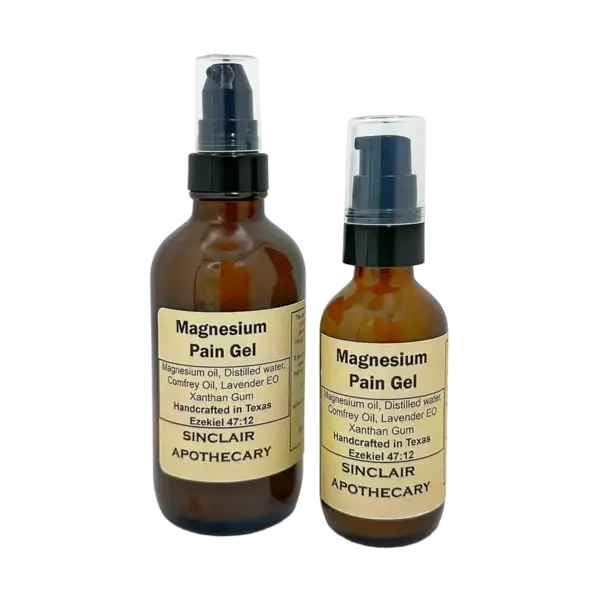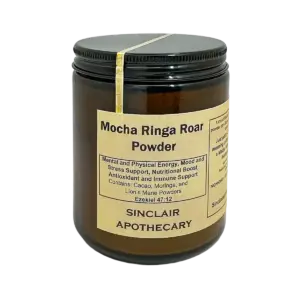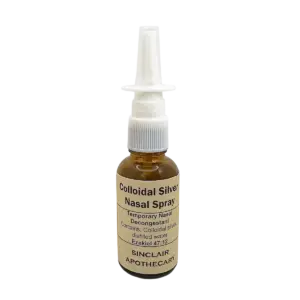Magnesium Pain Gel w/Lavender
Price range: $45.00 through $75.00
A gel combining magnesium and Symphytum officinale (comfrey) with xanthan gum and distilled water can relieve muscle pain, reduce inflammation, and promote healing of minor skin injuries. Its smooth, hydrating texture ensures easy application, but caution is needed due to comfrey’s potential toxicity with prolonged use.
- Premium Quality
- Secure Payments
- National Shipping
Description
Magnesium Pain Gel w/ Lavender
A gel made with magnesium, Symphytum officinale (commonly known as comfrey), lavender, using xanthan gum and distilled water as a base, can offer several potential benefits, particularly for topical applications. Below is a detailed breakdown of the benefits based on the properties of each ingredient:
1. Magnesium
Magnesium is a vital mineral with numerous health benefits, especially when applied topically in a gel form:
- Muscle Relaxation and Pain Relief: Magnesium is known for its ability to relax muscles and reduce cramping or soreness. Topical magnesium gel can be absorbed through the skin, helping to alleviate muscle tension, spasms, and joint pain. This makes it particularly useful for athletes or individuals with chronic muscle pain.
- Anti-Inflammatory Effects: Magnesium may reduce inflammation in localized areas, potentially aiding conditions like arthritis or muscle injuries.
- Improved Skin Health: Magnesium can support skin barrier function and hydration, potentially benefiting conditions like eczema or psoriasis when applied topically.
- Stress Relief: Magnesium is sometimes called the “relaxation mineral” because it supports the nervous system, potentially reducing stress-related tension when absorbed through the skin.
- Enhanced Absorption: Transdermal magnesium (absorbed through the skin) may bypass digestive issues associated with oral supplements, providing a more direct delivery to tissues.
2. Symphytum officinale (Comfrey)
Comfrey has been used traditionally in herbal medicine for its healing properties, particularly for skin and musculoskeletal issues:
- Wound Healing: Comfrey contains allantoin, a compound known to promote cell proliferation and tissue repair. This makes it effective for healing minor cuts, scrapes, burns, or abrasions when applied topically.
- Anti-Inflammatory Properties: Comfrey may reduce inflammation in conditions like sprains, bruises, or joint pain, complementing magnesium’s effects.
- Bone and Tissue Support: Traditionally called “knitbone,” comfrey has been used to support the healing of bruises, sprains, and even minor fractures due to its regenerative properties.
- Skin Soothing: Comfrey can soothe irritated skin and reduce discomfort from conditions like dermatitis or insect bites.
- Caution: Comfrey contains pyrrolizidine alkaloids, which can be toxic to the liver if ingested or used excessively. For topical use, ensure the gel is made from comfrey extracts that are low in these alkaloids, and avoid applying to broken skin or using for prolonged periods.
3. Lavender
Lavender, typically used as an essential oil in topical formulations, adds aromatic and therapeutic properties that enhance the gel’s overall efficacy:
- Pain Relief and Anti-Inflammatory Effects: Lavender oil has numbing and anti-inflammatory properties that can soothe painful inflammation, making it complementary to magnesium and comfrey for reducing muscle soreness, joint pain, and conditions like arthritis.
- Skin Healing and Regeneration: It promotes wound healing, tissue repair, and reduces the appearance of acne or scars by accelerating cell regeneration and fighting infections, synergizing with comfrey’s allantoin.
- Calming and Stress Reduction: The oil’s anxiolytic effects can relieve stress and promote relaxation when absorbed through the skin, enhancing magnesium’s “relaxation mineral” benefits.
- Antimicrobial and Antioxidant Support: Lavender provides antimicrobial activity to prevent infections in minor wounds and antioxidant effects to protect skin from free radicals, improving overall skin health.
- Soothing for Irritated Skin: It calms redness, irritation, and conditions like eczema or insect bites, while its pleasant scent improves the user experience in gels.
4. Xanthan Gum
Xanthan gum serves as a gelling agent and stabilizer in the formulation, contributing to the gel’s texture and usability:
- Smooth Texture and Stability: Xanthan gum creates a smooth, spreadable gel that ensures even application of active ingredients (magnesium, comfrey, and lavender) on the skin.
- Hydration: It helps retain moisture in the gel, keeping the skin hydrated during application.
- Non-Irritating: Xanthan gum is generally well-tolerated and non-comedogenic, making it suitable for sensitive skin types.
- Enhanced Delivery: By forming a stable gel matrix, xanthan gum ensures that the active ingredients remain in contact with the skin for longer, potentially improving absorption.
5. Distilled Water
Distilled water is used as a solvent and base for the gel, offering the following benefits:
- Purity: Distilled water is free of contaminants, minerals, and impurities, reducing the risk of skin irritation or reactions, especially for sensitive skin.
- Neutral Base: It provides a clean medium for dissolving and dispersing magnesium, comfrey, and lavender extracts without interfering with their properties.
- Hydration: The water content in the gel helps hydrate the skin, enhancing the soothing effects of the other ingredients.
Combined Benefits of the Gel
When combined, these ingredients create a synergistic topical gel with potential applications for:
- Pain and Inflammation Relief: The trio of magnesium’s muscle-relaxing properties, comfrey’s tissue-repairing effects, and lavender’s numbing anti-inflammatory action can be highly effective for conditions like muscle soreness, joint pain, arthritis, or minor injuries.
- Skin Healing and Repair: Comfrey’s allantoin, lavender’s regenerative and antimicrobial benefits, and magnesium’s skin-supporting properties promote healing of minor wounds, bruises, acne, or irritated skin.
- Improved Skin Comfort and Relaxation: The gel’s hydrating and soothing properties (from xanthan gum, distilled water, and lavender’s calming scent) make it comfortable to apply, even on sensitive or damaged skin, while aiding stress relief.
- Ease of Use: The gel format, thanks to xanthan gum, allows for easy application and targeted delivery to affected areas, with lavender enhancing the sensory experience.
Considerations and Precautions
- Patch Test: Always perform a patch test before widespread use to ensure no allergic reactions to comfrey, lavender, or other ingredients.
- Comfrey Safety: Use comfrey-based products cautiously, as prolonged or excessive topical use may lead to absorption of pyrrolizidine alkaloids. Consult a healthcare provider, especially for long-term use or application on large areas.
- Magnesium Sensitivity: Some individuals may experience mild skin irritation from topical magnesium. Diluting the gel or reducing frequency can help.
- Lavender Safety: Lavender essential oil is generally safe for topical use in gels and compatible with xanthan gum, but dilute properly to avoid irritation in sensitive individuals; it’s non-toxic and suitable for most skin types.
- Consult a Professional: If using the gel for medical conditions (e.g., arthritis or chronic pain), consult a healthcare provider to ensure it’s appropriate for your needs.
Conclusion
A gel made with magnesium, Symphytum officinale, lavender, xanthan gum, and distilled water can be a powerful topical remedy for muscle and joint pain, inflammation, skin healing, and relaxation. Its benefits stem from magnesium’s relaxing effects, comfrey’s tissue-healing properties, lavender’s soothing and anti-inflammatory action, and the stable, hydrating base provided by xanthan gum and distilled water. However, safe use requires attention to comfrey’s potential risks, proper dilution of lavender, and individual skin sensitivities.
Additional information
|
||
| Dimensions | ||
|---|---|---|
|
||
You must be logged in to post a review.






Reviews
There are no reviews yet.